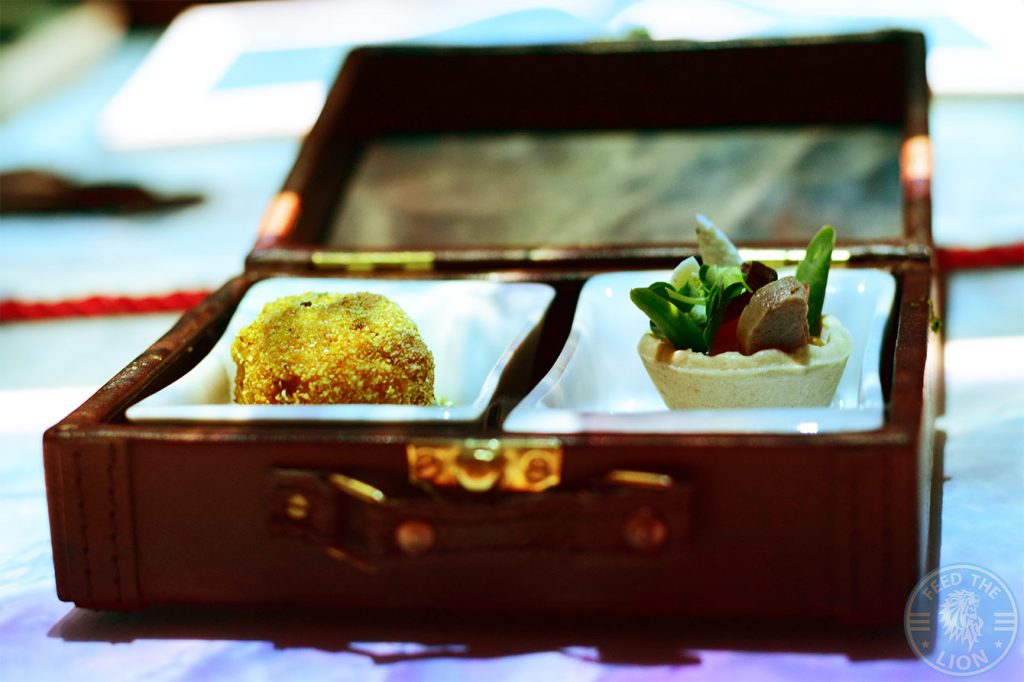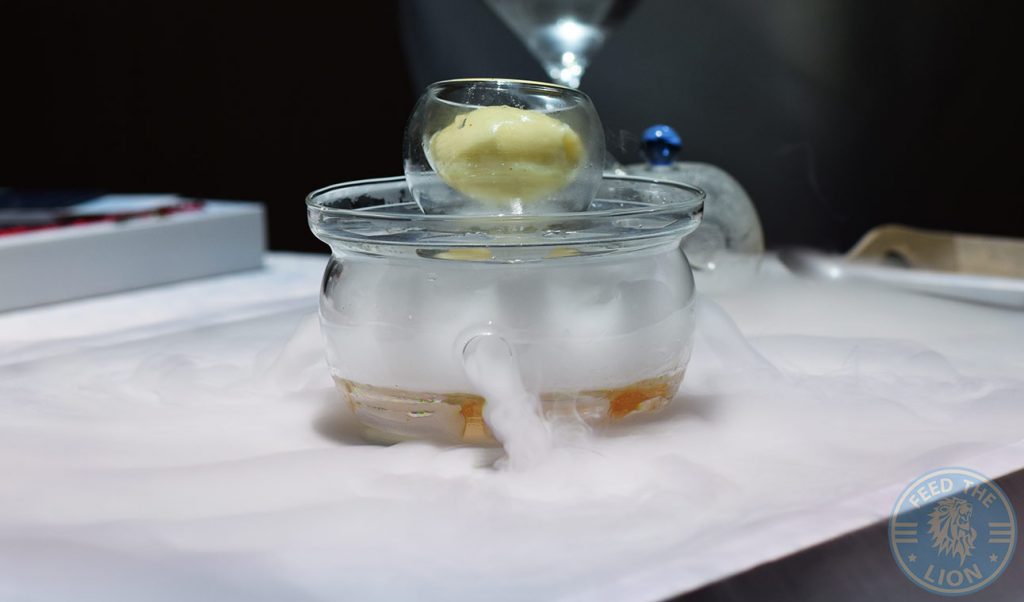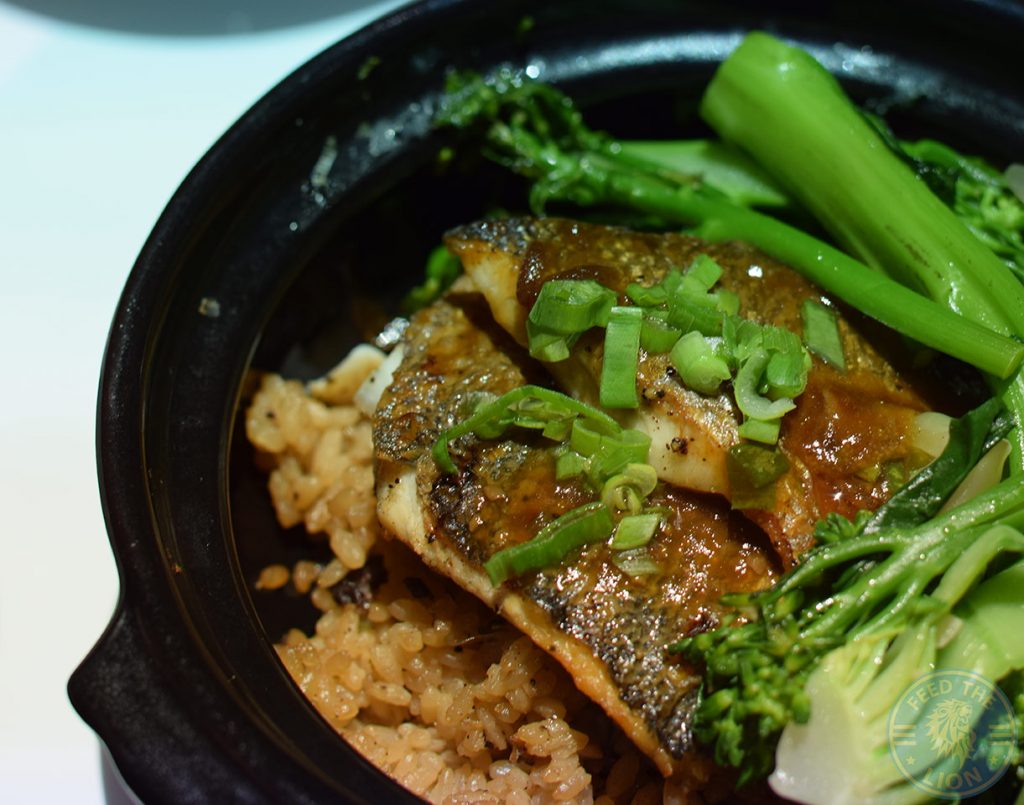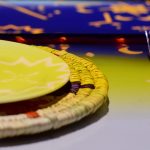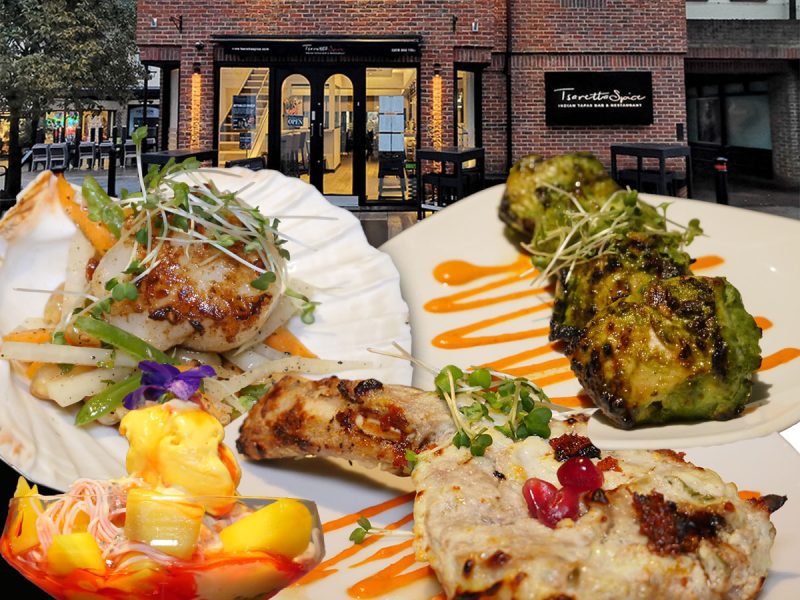Dinner Time Stories, Le Petit Chef (Fine Dining) – Dubai
Le Petit Chef “Dinner Time Stories” is a fine dining establishment that offers an immersive, high-end concept-based dining experience (adult AED 450, child AED 225) in the heart of downtown Dubai.
3-D mapped animated holograms weave tales of the legendary travels of Marco Polo and the extravagant six-course menu pays tribute to the diversity of cuisines that he discovered along his journey.
 Once seated and greeted in welcome, we were served a beverage of their choice and offered a selection for the main course: beef, duck, sea-bass, or oyster mushrooms, to be accompanied by Chinese-style rice.
Once seated and greeted in welcome, we were served a beverage of their choice and offered a selection for the main course: beef, duck, sea-bass, or oyster mushrooms, to be accompanied by Chinese-style rice.
The rest of the menu remained a mystery; each course being revealed after a chapter of the story played out in prelude, cleverly building anticipation for the plateful to follow.
An immersive, mesmerising feast of sound and vision, the storytelling features almost palpably realistic graphics – albeit the sort that loses something in translation when captured through a lens for posterity.
It began with the dimming of lights followed by overhead projectors bringing to vibrant life the diners’ hitherto blank table top books. For Le Petit Chef, the delightful holographic host and guide, the entrada began in his native France.
He talked of seeking and finding culinary inspiration in ‘The Travels of Marco Polo’, and of impulsively following in the great explorer’s wake. As he took to the perilous seas in his little paper boat, we were served the first course.
The menu, printed on an origami boat for good measure, described an amuse-bouche of Tart Nicoise and Mushroom Polenta Cube, with a shot of Tomato-Basil Water.
It was served, fittingly, in a charming little treasure-chest atop gentle animated waves still unfurling on the plate. The tartlet, an attempt at capturing the flavours of the famous salad in a single, delicately arranged bite, fell a bit short: lacking binding, while the filling amounted to a medley of disparate ingredients instead of a cohesive mouthful. The only lingering taste was that of the crumbly shell.
The polenta was warm and crisp, but altogether quite unremarkable in flavour.
The story resumed with Le Petit Chef being washed ashore before covertly sampling delicacies from a lavish Arabian spread, serenaded by traditional music. He is discovered and thus banished to the desert, and while being buffeted by sandy winds, we turned to the second course.
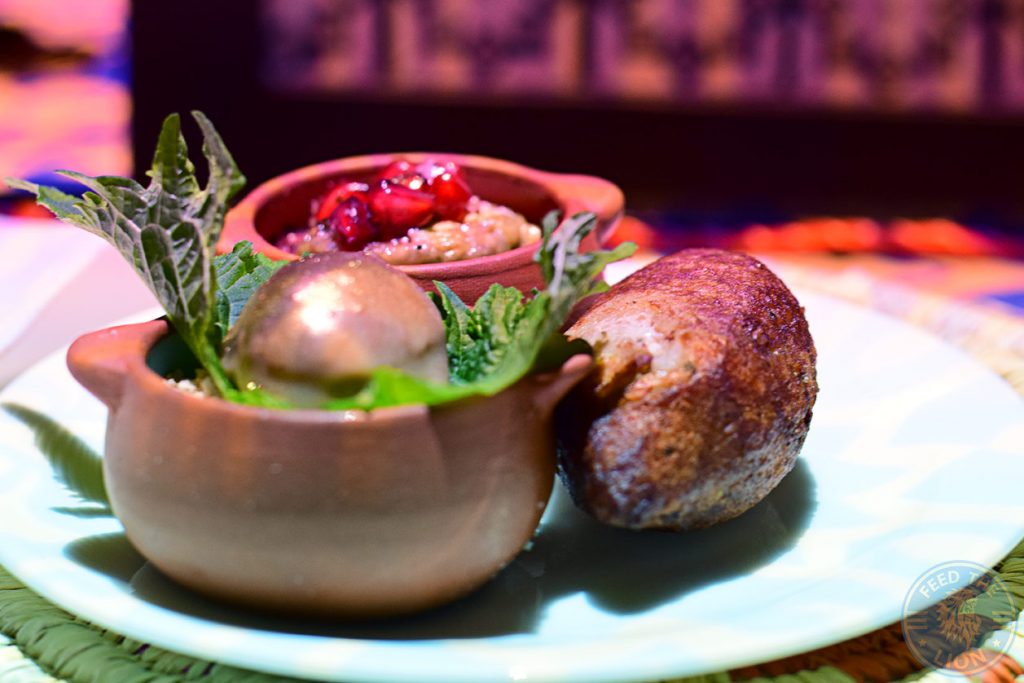
Quail Kibbeh – Eggplant and Labneh dip with herbs and pomegranate seeds, and a Walnut Shell Mohammara
The music swelled again and gold-and-blue mandalas swirled across the table tops as a boxful of Arabian delicacies arrived.
The lid slid away to reveal an assortment of clay pots and a miniature hookah, and arguably the best course of the repertoire.
 The menu card listed a Quail Kibbeh – an Eggplant and Labneh dip with herbs and pomegranate seeds, and a Walnut Shell Mohammara. The kibbeh, perfectly formed and cleverly prepared with a heart of fragrant, gently spiced quail stew, was a surprisingly moist and tender morsel.
The menu card listed a Quail Kibbeh – an Eggplant and Labneh dip with herbs and pomegranate seeds, and a Walnut Shell Mohammara. The kibbeh, perfectly formed and cleverly prepared with a heart of fragrant, gently spiced quail stew, was a surprisingly moist and tender morsel.
The dip was tangy and delicious, with the pomegranate seeds a sweet and bright contrast to the meltingly soft eggplant and fresh yoghurt.
The mohammara was a work of art: a gilded cocoa butter shell, impossibly delicate, and encasing a pleasantly piquant red paste. This course, above all others, kept authenticity in perspective even as it added creative flair with unexpected ingredients and flavours to set itself apart.
Diners next encountered their host as he was rescued from his plight by a curious bird that agreed to join him on his quest for inspiration. In pursuit of “the world’s finest spices”, his companion flies him to the bright bustle of a bazaar in India – and so, as a riot of colour fades on the page, came the third course.
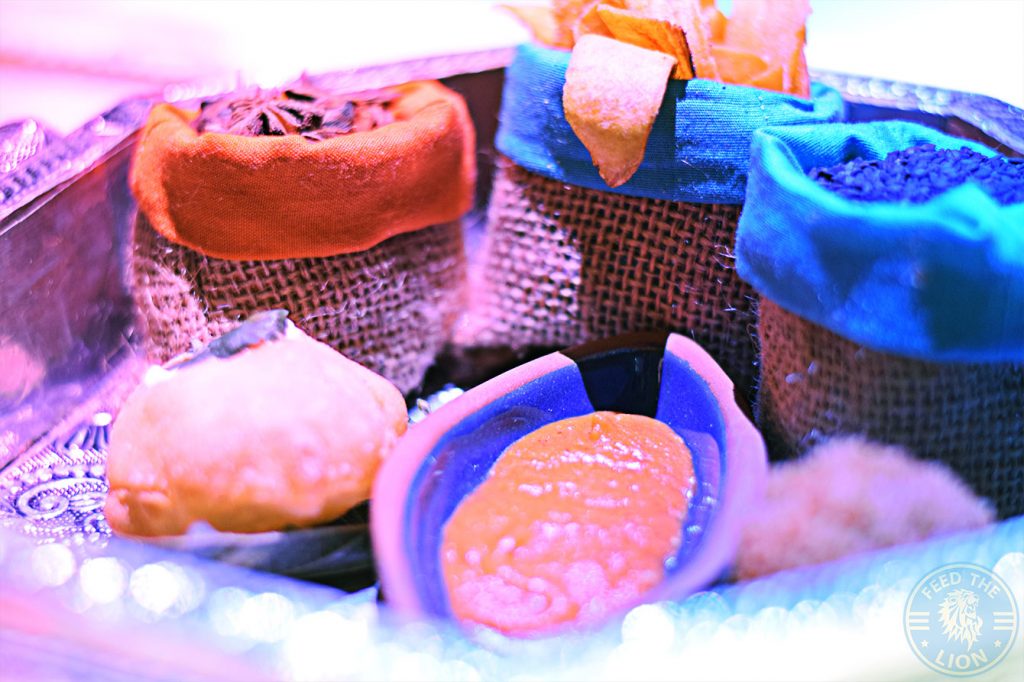
Spicy Prawns and Tamarillo in Chickpea Domes (Pani Puri), Plantain Fritters with Indian Spices, and a Jackfruit Cutlet with Spicy Mango Dip
Served in a carved platter resembling traditional Indian silverware, complete with tiny, decorative jute sacks of star anise and nigella seeds arranged alongside for good measure, are Spicy Prawns and Tamarillo in Chickpea Domes (Pani Puri), Plantain Fritters with Indian Spices, and a Jackfruit Cutlet with Spicy Mango Dip.
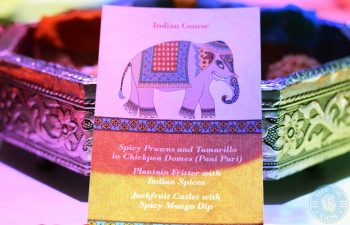 To those familiar with the incredible richness and diversity of Indian subcontinental cuisine, this combination is odd to say the least.
To those familiar with the incredible richness and diversity of Indian subcontinental cuisine, this combination is odd to say the least.
Pani puri, a crisp, puffed shell, is indeed a well-known street snack from the region; however, a filling of sauce-wet, slightly chewy prawn is unheard of. It maybe intended, perhaps, as a twist on the normal variants of chickpea, potato, and/or onion doused in a spiced tamarind sauce, but it makes for a confusing and not altogether palatable mouthful.
For all the little chef’s rhapsodising about Indian spices, the jackfruit cutlet was thoroughly bland, and its texture too wetly soft to scoop the accompanying mango chutney. The dip was left to the very ordinary plantain fingers instead.
In all, this course failed at serving a fitting ode to a grand cuisine, with a hapless menu of items that were still more confusing in light of the plethora of available alternatives.
The page turned, and Le Petit Chef and his gracious friend departed for the lofty Himalayas, bound for China. An echo of temple gongs swelled and faded as he dived out of sight, descending into the snowy peaks.
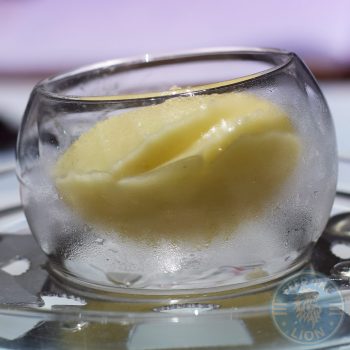 Served thereafter was a perfect, pale yellow quenelle of Lychee, Pineapple, and Ginger Sorbet plated over a glass pot, with a tiny glass teapot of hot water beside it.
Served thereafter was a perfect, pale yellow quenelle of Lychee, Pineapple, and Ginger Sorbet plated over a glass pot, with a tiny glass teapot of hot water beside it.
The water, poured through the plate and into the pot beneath, released dry ice plumes that spilt over onto the table in breath-taking, billowing gossamer waterfalls not unlike the white mists of the mountains where the little chef last landed.
The sorbet itself was an excellent palate cleanser: fresh and invigorating, with the ideal balance of fruit-and-spice flavours.
Diners then saw the chef soaring over snowy valleys, verdant tea gardens, even the Great Wall, and helping himself to a vibrant spread of Chinese delicacies before being chased into a hasty exit by a guardian dragon.
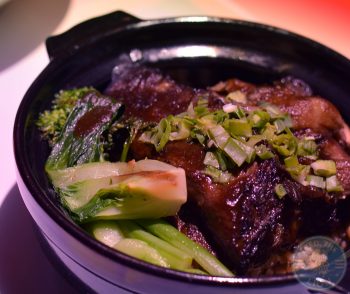 The mains – the Chinese course – were brought out as ordered.
The mains – the Chinese course – were brought out as ordered.
The portion of rice was large, and comprised the strange choice of risotto-like grains instead of a more Asian variant.
Of the proteins, the sea-bass fillet was tender and flaky if not a tad bland.
The duck was overdone: the meat unappealingly stringy, and missing the quintessential crispy skin.
The beef, while tender, was served in chunks too large to make for a convenient morsel, and the choice of serving utensil made it awkward to try and cut both it and the sea bass to size.
The flavours of the sauces, primarily soy and hoisin per the menu, were undetectable, likely absorbed entirely by the rice.
Our story concluded: Odysseus returns home, full of inspiration for his restaurant. He makes his guests a tableside dessert, laboriously hauling the weight of stirring-spoons and the ingredients he has collected on his travels to present a dessert of sweet golden pudding.
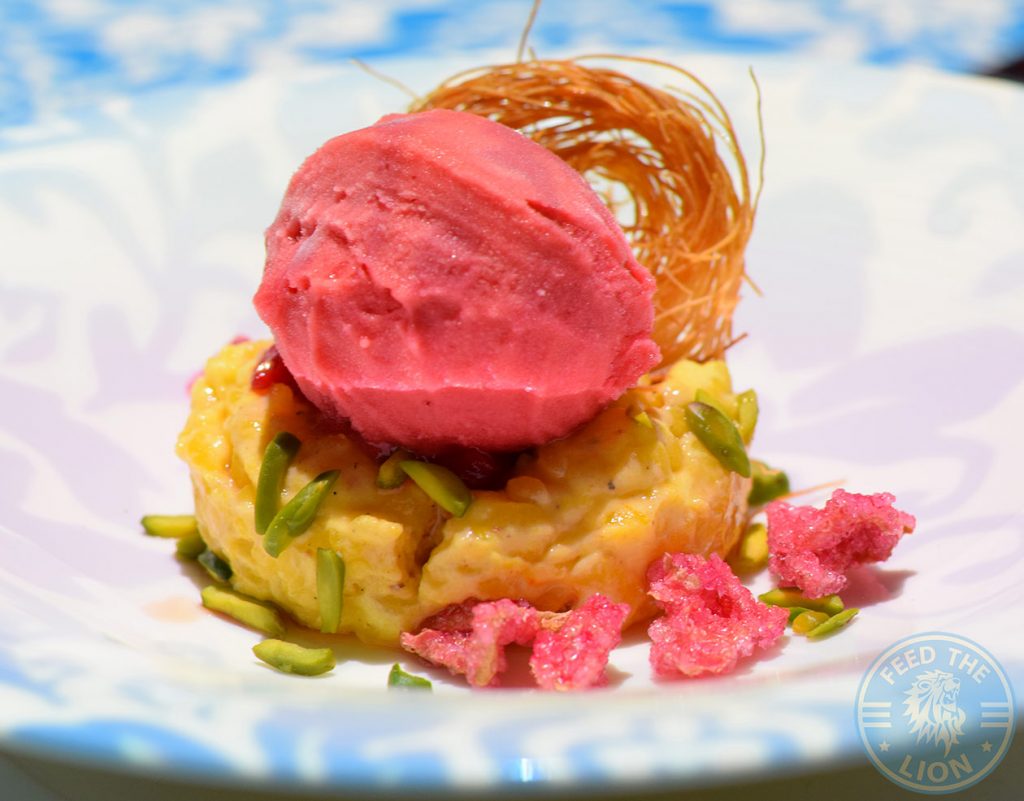
Rice Pudding with Saffron, Cardamom, and Pistachio, served with Hibiscus and Raspberry Sorbet, Rose Petals, and Crunchy Kunafa
The actual dessert was brought out: Rice Pudding with Saffron, Cardamom, and Pistachio, served with Hibiscus and Raspberry Sorbet, Rose Petals, and Crunchy Kunafa.
Aside from repetitive elements of sorbet and rice, the plate included a crisp-roasted vermicelli spiral in lieu of kunafa – an Arabic dessert that those familiar with the cuisine would know as being vastly different – and a garnish of three sugared petals.
While the sorbet was puckeringly tart, the oddly textured and lumpy rice pudding, alas, too bland to work as a sufficient counter.
The plateful of elements did not come together as a harmonious whole. As such, the dessert was a disappointing end to the meal.



